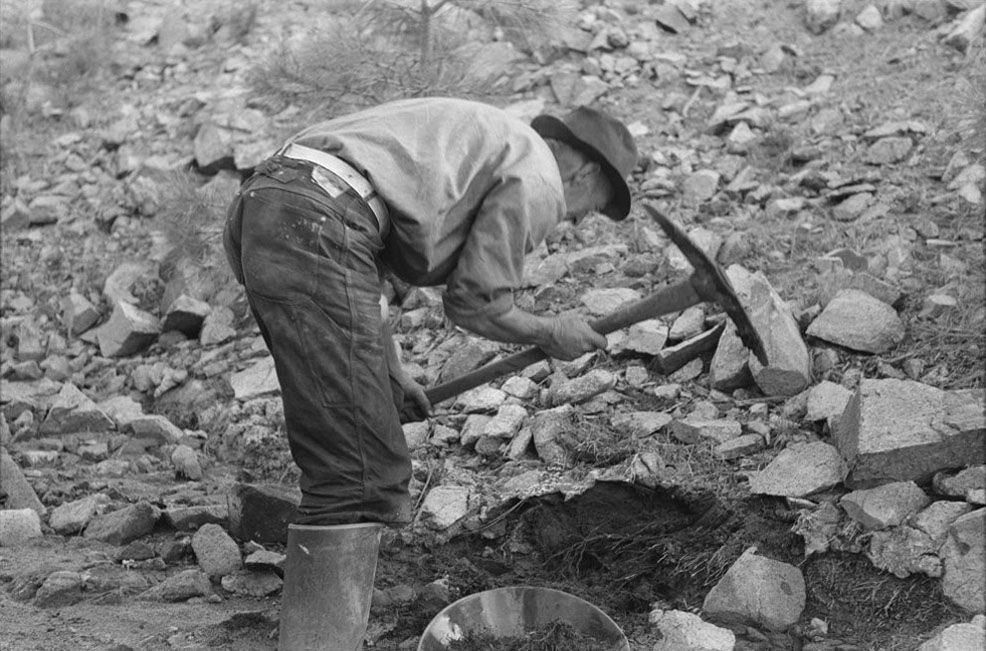
Gold prospector, Pinos Altos, New Mexico, 1940. (Source: Library of Congress)
Real news, it has been said, is what many people want to keep hidden; everything else is publicity. Our goal here is to share stories by reporters who are out there digging in the muck and exposing the corruption eroding American democracy. Some are old school, wearing out shoe leather and wooing sources. Others are data crunchers, teasing out patterns to expose the graft that leaves people and places in ruins. Investigative journalism doesn’t come cheap; it is labor-intensive and time-consuming. But, as the stories below show, we are much better off when these intrepid journalists are out there digging.
To kick off this series, we look at some investigations that caught our attention and in a separate post recommend some investigative organizations that are worth following in 2017. If you see an investigation that deserves our attention, please let us know via Twitter or Facebook.
Want to Fix Gun Violence in America? Go Local
— The Guardian
This interactive report maps gun violence in neighborhoods across America, revealing that half of all gun deaths are concentrated in 127 cities, even though those cities contain less than a quarter of the nation’s population. “The concentration of gun violence in America more closely resembles the spread of a contagious disease. Inequity and poverty are risk factors. But violence itself may spread from person to person like a virus, meaning that particular networks of people, not whole neighborhoods or demographic groups, are most at risk.” For a number of cities — Baltimore, Chicago, New Orleans, New York, Oakland and St. Louis — The Guardian peels back layers of data relating to race, education and poverty to explain the unequal burden of this deadly epidemic.
The Politics of Pain
— The Center for Public Integrity and The Associated Press
While most everyone else was mesmerized by the national election, a team of reporters tackled the addiction struggles that plague white working-class Americans. It is a damning report, revealing that politics is enabling addicts. “Drug companies have developed a 50-state strategy to combat laws that would stem the tide of prescription painkillers, complete with lobbying and campaign contributions adding up to more than $880 million nationwide from 2006 through 2016.” The result: People die — 165,000 over the past 10 years. Many of the grass-roots organizations fighting for tighter regulations are launched by parents whose children became hooked on painkillers and are eventually lost to heroin. The latest story in the series exposes how some grieving parents are exploited by a shameless industry that is using them to plug their latest profitable, but unproven, pills.
Corporations Prepare to Gorge on Tax Cuts Trump Claims Will Create Jobs
— The Intercept
The US Chamber of Commerce has claimed that if US-based multinational corporations get a tax break, they will use it to bring home their offshore accounts and hire millions of Americans. Yeah, right. After Election Day, reporter Jon Schwarz began combing through dozens of earnings calls and investor conference talks and learned that many executives don’t pretend that domestic hiring is in the cards. Instead, they have been telling bank analysts that they are “eager to take the money to increase dividends and stock buybacks as well as snap up competitors.” The more likely result of this profit repatriation concludes Schwarz is that “the yawning chasm between the richest Americans and everyone else will just get wider.”
Who Got Rich off the Student Debt Crisis?
— The Center for Investigative Reporting and Consumer Reports
This devastating expose, published last summer, is a revealing and cautionary tale of the human costs of privatizing a government lending program. Sallie Mae, the student loan corporation meant to help middle- and low-income students earn college degrees, is now a profit center for Wall Street and a killer of student dreams. “Step by step, Congress has enacted one law after another to make student debt the worst kind of debt for Americans — and the best kind for banks and debt collectors. Today, just about everyone involved in the student loan industry makes money off students — the banks, private investors, even the federal government.” The students, on the other hand, flounder — 1 in 4 borrowers are behind on their payments and nearly 8 million are in default.
Trump’s Empire: A Maze of Debts and Opaque Ties
— The New York Times
When President elect Trump said at this week’s press conference that he has “very, very little debt,” it felt like a good time to reread this August report. Susanne Craig dove into the murky waters of Trump’s US real estate holdings, where she found “companies he owns have at least $650 million in debt — twice the amount than can be gleaned from public filings he has made as part of his bid for the White House.” While Trump publicly disclosed that he owes at least $315 million to a small group of lenders, he only listed the debt for companies he controls. By The Times’ tally, Trump is involved in partnerships that are on the hook for $2 billion to a wide web of lenders. It’s not Trump’s debt alone, of course, but it is certainly in his financial interest not to default. In December, Russ Choma, of Mother Jones, also took a turn at navigating Trump’s debt. He created A Guide to Donald Trump’s Huge Debts — and the Conflicts They Present, in which he broke out all of the financial players that have critical and potentially conflicting financial relationships with the president elect.
Beyond Homelessness
— San Francisco Chronicle and Bay Area News Outlets
The Chronicle, along with more than 80 additional news organizations in the Bay Area, pooled their resources to examine the forces that push people to live on the streets, and to search for solutions that might ease their suffering. The result is an ever-expanding series of articles and videos that provide a wider lens on a seemingly intractable problem.
Read more in our series highlighting the best investigative reporting. And don’t miss our list of 10 investigative reporting outlets worth following.




